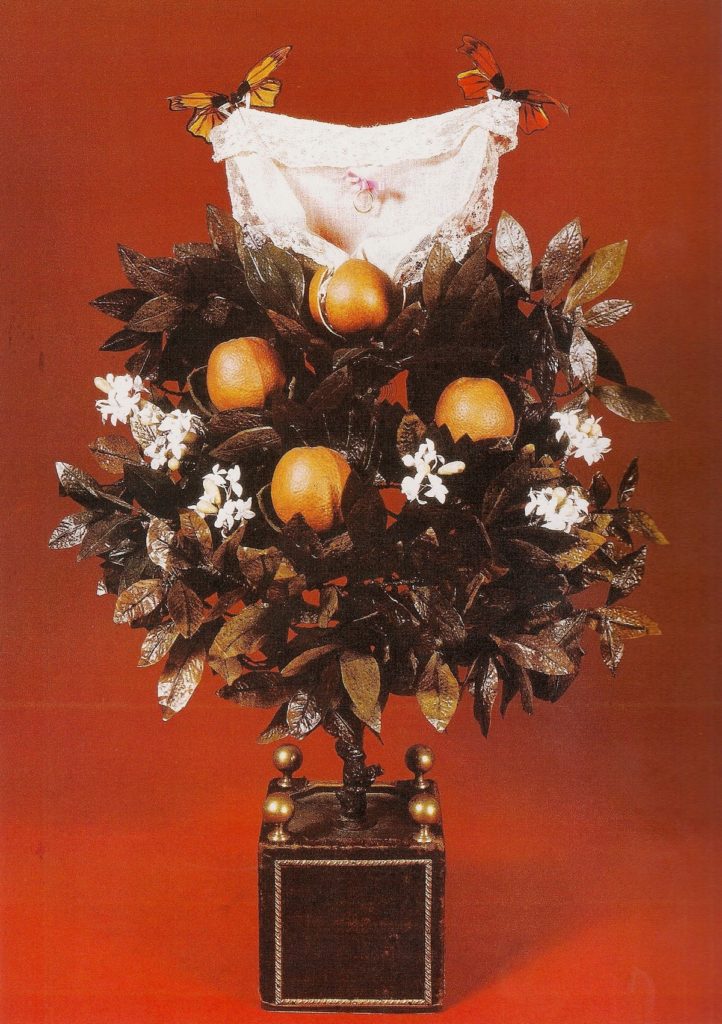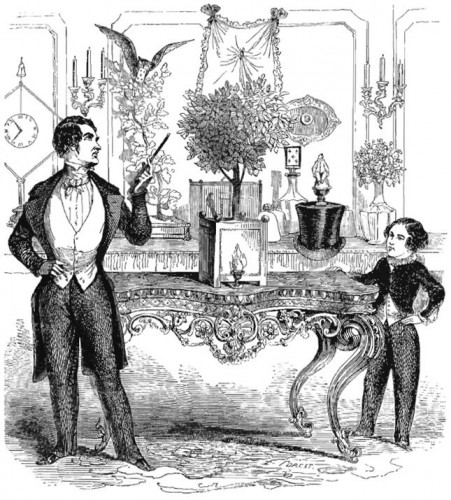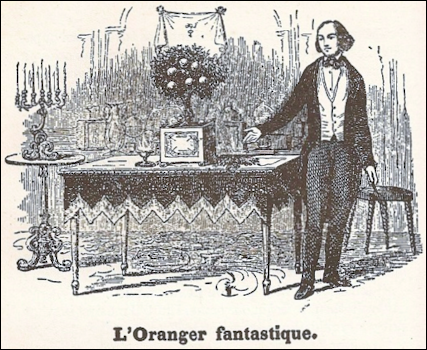The Marvelous Orange Tree, alternatively known as the Orange Tree Trick or the Orange Tree Illusion “L’Oranger Merveilleux,” or “L’Oranger Fantastique” is one of the most famous illusions of all time, standing as a testament to the genius of magician Jean Eugène Robert-Houdin, widely regarded as the father of modern magic. Unveiled in the mid-19th century, this illusion blends mechanical brilliance with a profound representation of life, the passage of time, and the magic of teleportation. This iconic trick epitomizes Robert-Houdin’s groundbreaking approach, not only showcasing his technical skill but also his ability to imbue inanimate objects with a semblance of life.
Background and Invention
Jean Eugène Robert-Houdin, born in 1805 in Blois, France, emerged as a master illusionist during a pivotal era in history. The mid-19th century was a time of profound transformation, marked by the Industrial Revolution’s sweeping changes and scientific discoveries. This period saw the burgeoning of steam power, the rise of mechanized manufacturing, and a growing fascination with automata – mechanical devices that imitated human actions.
As society grappled with these rapid advancements, there was a parallel rise in public entertainment. Theatrical performances, once a rarity confined to the upper echelons of society, were becoming increasingly popular among the broader public. New theaters and performance halls were springing up across Europe, reflecting a growing appetite for diverse forms of entertainment.
Robert-Houdin, initially a watchmaker, was uniquely positioned to capitalize. His background in mechanics and his fascination with automatons fueled many of his magic creations, leading to marvels that had never been seen before.
The Inception of The Marvelous Orange Tree
Among Robert-Houdin’s many inventions, The Marvelous Orange Tree stands out for its complexity and symbolism. This illusion, a fusion of mechanical ingenuity and theatrical flair, was conceptualized against the backdrop of a society enamored with technological wonders and the mysteries of the natural world. The mid-19th century was also a time when spiritualism and a fascination with the supernatural began to take hold, influencing the themes prevalent in the arts and entertainment.
The Marvelous Orange Tree was more than just a magic trick; it was a reflection of its time – a period that saw the boundaries between science, art, and the supernatural becoming increasingly blurred. This illusion, with its mechanical tree that blossomed and bore fruit in front of an astounded audience, was a metaphor for the era’s infatuation with creation, life, and the possibilities of technology.
The Illusion: A Mirror to the Age
The Marvelous Orange Tree Illusion spoke to the mid-19th century’s fascination with the interplay of nature, science, and the mystical.
The illusion involves a small, seemingly barren tree, sat on a table on center stage. During the performance, the tree miraculously blossoms before the audience’s eyes, bearing oranges. The highlight of the trick occurs when two butterflies or bees appear from behind the tree, which proceed to hover upwards, flapping their wings, levitating above the tree. In some versions of the illusion, the butterflies carry between them a handkerchief, borrowed from a spectator, which had vanished earlier in the performance.
Technological Marvel Meets Artistic Vision
At the heart of The Marvelous Orange Tree was a feat of mechanical engineering that would have seemed almost miraculous to contemporary audiences. With an intricate system of springs, levers, and pulleys concealed within, the tree blossomed and bore fruit in a stunning display of art imitating life. This was a period where automata – self-operating machines that mimicked life – captivated public imagination, and Robert-Houdin’s illusion perfectly captured this trend.
Interplay with Spiritualism and Mysticism
The mid-19th century also saw a growing interest in spiritualism and the occult. The Marvelous Orange Tree resonated with these themes by invoking a sense of wonder and the inexplicable. The moment when the butterflies emerge, carrying a previously vanished handkerchief, was not just a display of technical skill but also a nod to the era’s fascination with the mystical and the otherworldly.
Reflection of Societal Changes
This period was also one of significant social change. The Industrial Revolution was altering the fabric of society, and with it, entertainment was becoming more accessible to the masses. The Marvelous Orange Tree, performed in theaters, symbolized this democratization of entertainment. It was no longer just the elite who could enjoy such marvels; magic had become a form of entertainment that crossed social boundaries, much like the technological innovations of the time.
Legacy and Influence
The Marvelous Orange Tree holds a special place in the annals of magic history for its blend of mechanical artistry and theatrical illusion. It marks the transition of magic from simple sleight of hand tricks meant to baffle and con, often seen as lowbrow entertainment, to complex, story-driven performances of illusions meant for high society. In short, it showed that magic can be a true form of art.
It also resonated deeply with the societal shifts and political changes unfolding in France and across Europe during the mid-19th century, a time characterized by a growing appetite for innovation, democratization, and artistic expression.
Reflecting Societal and Political Transformations
In France, the period of Robert-Houdin’s prominence was one of significant upheaval and transformation. The illusion of The Marvelous Orange Tree, in many ways, mirrored the societal changes during the turbulent years following the French Revolution and the Industrial Revolution. The spectacle of a tree blossoming through magic could be seen as a metaphor for the era’s aspirations towards growth, renewal, and the reimagining of social order. It exemplified the belief in progress and the power of human ingenuity, themes that were central to the spirit of the age.
Inspiring Future Generations of Magicians
Robert-Houdin’s legacy, exemplified by The Marvelous Orange Tree, paved the way for future generations of magicians. It shifted magic from mere sleight of hand and deceptive practices to an art form that embraced story, spectacle, and technological innovation. This transformation opened up new possibilities in the realm of magical performance, influencing magicians to incorporate narrative, character, and sophisticated mechanical devices into their acts.
Magicians such as Harry Houdini, who adopted Robert-Houdin’s name to signify his admiration, continued this tradition of blending illusion with narrative and technological spectacle. The trend of using elaborate mechanical devices and creating narrative-driven performances became a cornerstone of modern magic, directly traceable to Robert-Houdin’s innovations.
Influence Beyond Magic: Art, Technology, and Entertainment
The Marvelous Orange Tree’s influence extended beyond the narrow confines of magic. It became a symbol of the era’s broader cultural fascination with automata and the potential of technology to mimic and enhance natural processes. This illusion, in its elegance and complexity, was not just entertainment; it was a commentary on the relationship between humans, technology, and nature – themes that were increasingly relevant in an age rapidly being reshaped by industrial and technological advancements.
The Marvelous Orange Tree thus echoes through time not only as a milestone in the history of magic but also as a reflection of a transformative period in history. It stands as a testament to the power of imagination and innovation to captivate, inspire, and reflect the spirit of an era.
In Popular Culture: A Lasting Fascination
The Marvelous Orange Tree continues to captivate the imagination of audiences well into the 21st century. It is a testament to the timeless nature of humanity’s fascination with the mystical but also the ingenious artifices of a golden age of machining and creativity.
Reflections in Film and Literature
In films like “The Illusionist” (2006), where a similar automaton plays a key role, we see a direct homage to the likes of The Marvelous Orange Tree. Such references in cinema and literature not only pay tribute to the illusion’s historical significance but also demonstrate how the themes of mystery, illusion, and the interplay between reality and fantasy continue to resonate with contemporary audiences. These modern portrayals echo the 19th-century allure of the mystical, blending the historical with the imaginative in a way that captivates modern viewers.
The Marvelous Orange Tree in Digital Media
The digital age has brought The Marvelous Orange Tree to new audiences, with online platforms offering access to performances, historical analyses, and discussions. A notable example is the performance by Paul Daniels, viewable on platforms like YouTube, allowing a global audience to experience a piece of magic history. This digital resurrection of the illusion highlights the continuing relevance of Robert-Houdin’s work in an era dominated by technology, not unlike the Industrial Revolution of his own time.
Contemporary Magic and the Illusion’s Influence
Contemporary magicians and illusionists often draw inspiration from The Marvelous Orange Tree, incorporating its essence into their performances, whether through direct reference or in the spirit of combining the mechanical with the magical. This ongoing influence in the magic community underscores the illusion’s role in shaping the art form and its narrative techniques. A notable example is Del Ray, whose radio-controlled marvels of the 1960s-80s were a brilliant homage, taking the stage machinations to a close up environment.
The Marvelous Orange Tree, a crowning achievement of Jean Eugène Robert-Houdin, stands as a testament to his enduring legacy as the father of modern magic. This ingenious melding of mechanics, artistry, and illusion not only reflects the spirit of its era but transcends it, offering a window into a time where the boundaries between the possible and the impossible were actively being redefined. This illusion, more than mere entertainment, symbolizes a cultural shift: it captures the zeitgeist of an age increasingly fascinated by the merging of art and technology, and the expanding horizons of human potential. In recognizing Robert-Houdin’s legacy through The Marvelous Orange Tree, we see that all magic is a reflection of its time, and a vibrant commentary on society’s aspirations and dreams. The illusion invites us to see beyond the ordinary, urging us to explore the endless possibilities that lie within the confluence of imagination, innovation, and the cultural spirit of an era.




